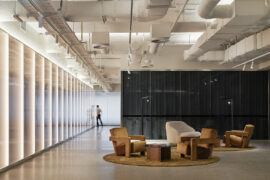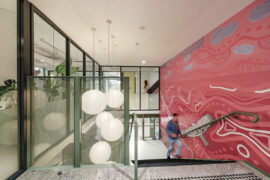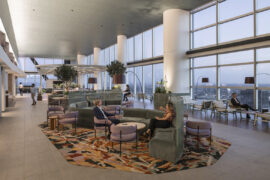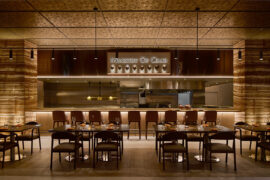There’s a lot we don’t know about the future of workplace. But even amidst the current uncertainty, Carr associate Richard Healy offers clarity on 6 key facets of workplace design.

There are inordinate lessons to be learned from the past 12 months, nowhere more so than in workplace design. With designers at the coalface of these changes, they are poised to understand better than anyone else how our working environments need to adapt.
Here, Carr associate Richard Healy shares his thoughts on key facets of the workplace and design processes.

Associate Richard Healy is an integral player within the workplace and commercial interiors team, at Carr.
Richard Healy: Strategic briefing is one of the most important parts of any project. It’s where you begin to understand the client’s project vision, business drivers, future aspirations, ethos and values. Getting a deep understanding of these provides the project team a clear roadmap of what the project is about for the client, and ultimately what they’re trying to achieve.
The briefing stage provides an opportunity to look to the future, explore new ideas and concepts, and challenge the way things get done. A really clear and detailed brief allows for the interior to become the living embodiment of a brand and a powerful way to communicate who you are as a business, and a living manifestation of your values and principles.
Over the past year we’ve seen the briefing process evolve to include virtual strategies to help businesses understand how to navigate hybrid working styles to ensure a sense of democracy for everyone.

The multi-award winning workplace of Norton Rose Fulbright, a law firm in Sydney, designed by Carr. Photo by Nicole England.
An extension of the virtual space is digital content – what do you want future talent, clients and stakeholders to see on the screen?
Before Covid-19, your workplace was the living embodiment of your brand, but how can that be represented in the virtual space? Do we need to look at digital etiquette training such as lighting, sound and camera quality, and what clothing looks the most professional on camera?

BCG Digital Ventures office, in Sydney, designed by Carr. Photo by Demus Rusli.
Democracy during 2020 has been a key component in the success of remote working. During this time everyone was in it together; however, now that we’re shifting to a flexible hybrid workstyle, democracy can easily be eroded. As we return to the office it’s easy to slip back into old habits, focusing the conversation only towards those in the room, with collaboration in person leaving those on the screen as observers rather than contributors.
How do we maintain the sense of inclusivity and democracy we had working remotely? How do we ensure those not in the room are equally included and part of the collaboration process?
Simple tweaks to workplace typologies may be enough to balance the conversation and collaboration so everyone feels included. Better technology can facilitate seamless and democratic collaboration for all, whether you’re in the room or not. The big question is how in a year of financial hardship do you invest in significant tech that may be outdated in three years’ time?

Boston Consulting Group, Canberra offices, designed by Carr. Photo by Lisa McKelvie.
The future of working together in real time where we collaborate instantaneously to solve a problem or complete a task is currently in question. Also known as synchronous working, this method requires tools, platforms and processes that need to be further finessed to ensure there is an engaging collaboration experience for all – regardless of working from the office or remotely. Likewise, asynchronous working – where individuals aren’t working together in real time, perhaps due to differing time zones or life commitments, but equally rely on access to live documents – also requires adequate tools and programs to enable individuals to be connected in order to be productive.
Businesses will need to interrogate their unique workflows and team outputs to understand how best to provide systems and tools to enable both synchronous and asynchronous working. The unavoidable time spent working in isolation at home during Covid-19 has reminded us the value of working in the same space as our colleagues and the benefit that brings to collaboration. Likewise, it has also shown us the value of working solo with no interruptions. How can a business structure its workplace to incorporate both synchronous and asynchronous working, and what tools and structures need to be in place to support this?

Red Energy headquarters, in Melbourne, designed by Carr. Photo by Earl Carter.
Acoustic performance in the workplace has long been a key focus when designing spaces, especially for agile or activity-based workplaces. What we’re seeing now is an even greater focus on acoustics as people return to the workplace.
Reviewing acoustic mapping during the briefing process helps businesses and designers understand the acoustic nuances that align with different work settings. People are more acoustically sensitive post-Covid and workplaces will need to be tailored to ensure there is acoustic layering. Failing to address this might discourage people from returning to the office altogether because it’s too distracting, loud or uncomfortable for people to be productive.

The new Melbourne workplace of law firm Lander & Rogers, designed by Carr. Photo by Peter Clarke Photography.
Positive change often follows major disruption – think how World War II encouraged women to enter the workforce. What positives will come out of this period of disruption, not only in workplace, but in society? What does success look like now, in 10 years and in 20 years’ time? How does the workplace facilitate growth, attract and retain talent?

The fitout of top-tier law firm, MinterEllison, in Melbourne, designed by Carr. Photo by Tom Blachford.
INDESIGN is on instagram
Follow @indesignlive
A searchable and comprehensive guide for specifying leading products and their suppliers
Keep up to date with the latest and greatest from our industry BFF's!

For a closer look behind the creative process, watch this video interview with Sebastian Nash, where he explores the making of King Living’s textile range – from fibre choices to design intent.

Sydney’s newest design concept store, HOW WE LIVE, explores the overlap between home and workplace – with a Surry Hills pop-up from Friday 28th November.

From the spark of an idea on the page to the launch of new pieces in a showroom is a journey every aspiring industrial and furnishing designer imagines making.

In an industry where design intent is often diluted by value management and procurement pressures, Klaro Industrial Design positions manufacturing as a creative ally – allowing commercial interior designers to deliver unique pieces aligned to the project’s original vision.

CBRE’s new Sydney workplace elevates the working life and celebrates design that is all style and sophistication.

From radical material reuse to office-to-school transformations, these five projects show how circular thinking is reshaping architecture, interiors and community spaces.

Designed by Woods Bagot, the new fit-out of a major resources company transforms 40,000-square-metres across 19 levels into interconnected villages that celebrate Western Australia’s diverse terrain.

In an industry where design intent is often diluted by value management and procurement pressures, Klaro Industrial Design positions manufacturing as a creative ally – allowing commercial interior designers to deliver unique pieces aligned to the project’s original vision.
The internet never sleeps! Here's the stuff you might have missed

J.AR OFFICE’s Norté in Mermaid Beach wins Best Restaurant Design 2025 for its moody, modernist take on coastal dining.

After more than two decades at Architects EAT, Eid Goh launches AIR, a new Melbourne-based studio focused on adaptive reuse, hospitality and human-centred design across commercial and civic projects.